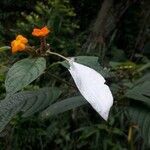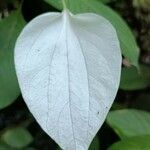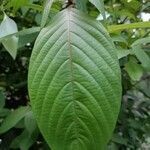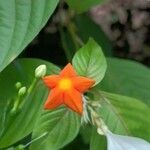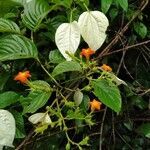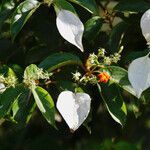Climbing shrubs; branches terete to compressed, moderately to densely pale red sericeous to hirsute becoming glabrescent, red-brown or brown, rather densely lenticellate. Leaves opposite; petiole 4-10 mm, densely sericeous; blade drying thinly papery or leathery, adaxially dark green to brownish green, abaxially pale green to yellowed, broadly elliptic, elliptic-oblong, ovate, or oblanceolate, 8-15 × 3-8 cm, both surfaces sparsely strigillose on lamina and strigose to sericeous on principal veins, base acute, obtuse, or rounded, apex acute to caudate-acuminate; secondary veins 7-10 pairs, tertiary venation visible and reticulate; stipules persistent, triangular, 5-10 mm, densely strigose to pilose, deeply 2-lobed, lobes lanceolate to narrowly triangular, acute to acuminate. Inflorescences congested-cymose becoming lax with lateral axes elongating markedly, 4-8 × 8-20 cm with lateral axes to 8 cm, sparsely to moderately pubescent with 2 types of pubescence, mixed strigillose to appressed puberulent and hirsute to villous, pedunculate or sessile and 3-partite; peduncles 1-3 cm; bracts triangular or elliptic, 4-10 mm, usually 2-to multifid, acute to acuminate; pedicels 1-6 mm. Flowers pedicellate, biology not noted. Calyx with hypanthium portion ellipsoid, 3-4 mm, strigose to sericeous; lobes narrowly triangular to narrowly ligulate, 7-12 mm, hirsute, acute to acuminate, with 1 lobe of 1-4 flowers per inflorescence sometimes expanded into calycophyll, blade elliptic-oblong to ovate, 6-8 × 2.5-5 cm, both surfaces glabrescent on lamina and strigillose on principal veins, base acute to cuneate, stipe 10-30 mm, apex acute or acuminate. Corolla salverform, outside hirsute; tube 22-25 mm; lobes ovate, 6-7 mm, acuminate. Berry ovoid or ellipsoid, ca. 10 × 7 mm, strigose to glabrescent, calyx limb deciduous. Fl. Apr-May.
More
A large climbing shrub. The stems are erect. It grows 3 m or more tall. The leaves are oblong and pointed. They are 15 cm long. They are downy underneath. The flowers are small and yellow. They occur in clusters at the ends of branches. They are trumpet shaped. The flowers have white sepals. The fruit is like a berry and is about 1 cm long. There are many seeds.
A tropical plant. It grows in tropical Asia. In Indonesia it grows from the coast up to 2,000 m above sea level. It is often on the edge of forests and near water. It needs regular moisture and fertile, sandy, humus-rich soil. The soil needs to be well-drained. It needs full sun. It occurs in the Western Ghats in India. It suits hardiness zones 10-12.
